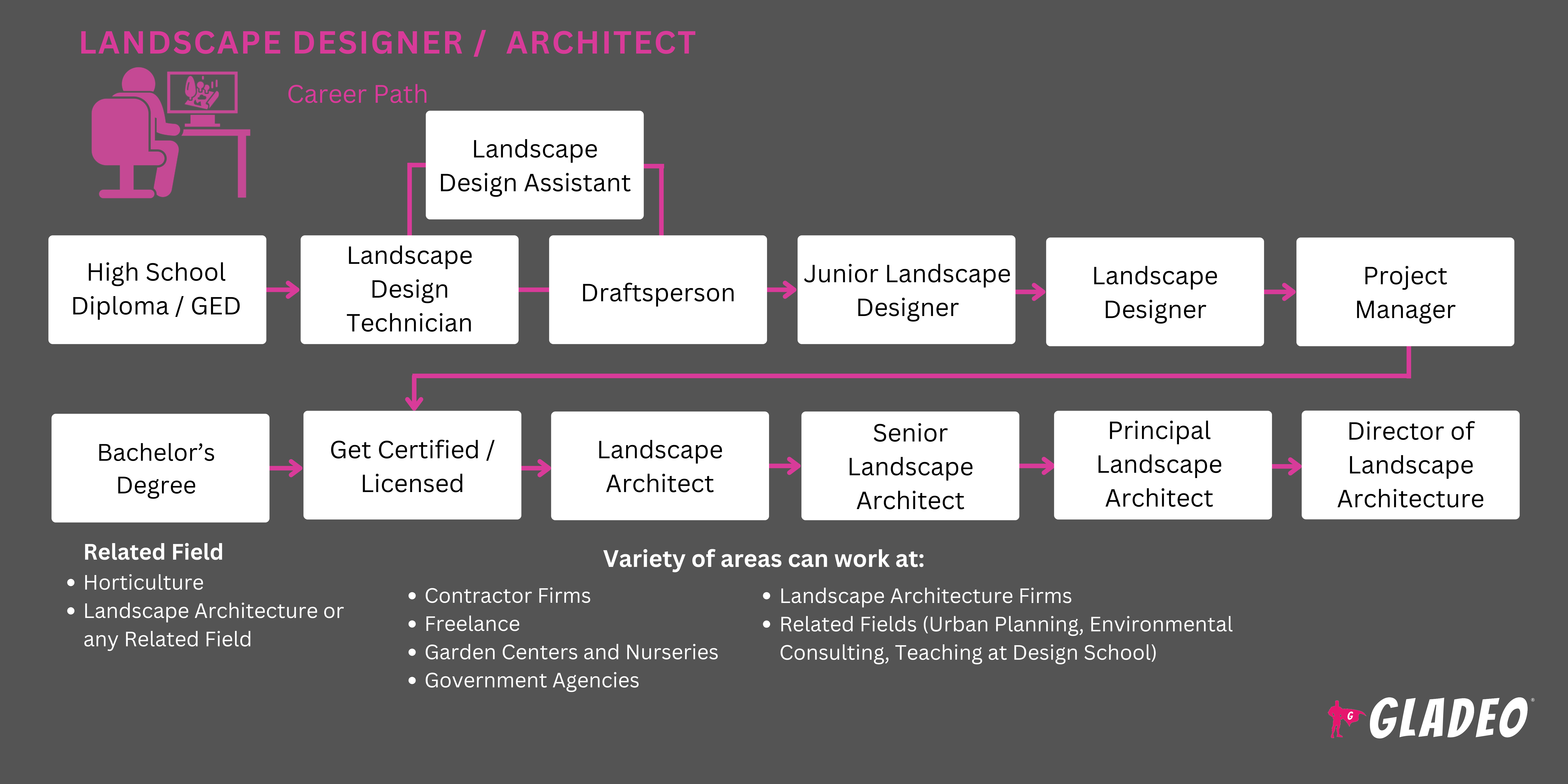Spotlights
Kiến trúc sư, Kiến trúc sư sân golf, Nhà quy hoạch đất đai, Kiến trúc sư cảnh quan, Nhà quy hoạch cảnh quan, Nhà quy hoạch công viên, Nhà quy hoạch, Kiến trúc sư cảnh quan chuyên nghiệp (PLA), Tư vấn cảnh quan, Nhà thiết kế sân vườn, Nhà thiết kế không gian ngoài trời, Quản lý dự án cảnh quan, Nhà quy hoạch trang web, Nhà thiết kế đô thị, Nhà thiết kế công viên, Nghệ sĩ cảnh quan
Landscape Designers and Landscape Architects use plants, trees, and manmade features such as fountains and lighting fixtures to bring outdoor spaces to life!
These landscape professionals transform parks, gardens, public spaces, corporate and college campuses, medical parks, and home yards into beautiful, eco-friendly spaces that promote wellness and tranquility. They literally help shape how we experience the outdoors!
To achieve this, they blend creativity with science, working closely with architects and city planners to ensure each project is sustainable and visually appealing. Everything is planned down to the last detail, from drainage and soil conditions to seating areas and plant selections, crafting spaces that connect people with nature while solving environmental challenges.
The key differences between Landscape Designers and Landscape Architects are their qualifications, project scope, and focus areas. For example, Landscape Architects usually hold a degree and are licensed, allowing them to manage large-scale projects that entail complex site planning, environmental impact assessments, and collaboration with engineers.
Landscape Designers focus on smaller, residential projects and don’t typically require a degree or license. Their work centers on aesthetic plant selection and layout design, beautifying spaces without the structural focus required in larger projects.
- Transforming outdoor spaces into beautiful, functional areas
- Contributing to environmental sustainability
- Làm việc ngoài trời với thiên nhiên
- Giữ cho cây, cây bụi và cây khỏe mạnh và an toàn khỏi sâu bệnh
- Tập thể dục hàng ngày
- Collaborating with a variety of professionals in different fields
Lịch làm việc
Landscape Designers and Landscape Architects typically work full-time, with overtime possible in some cases. They split their time between offices and outdoor sites, coordinating with clients, contractors, and other stakeholders.
Nhiệm vụ tiêu biểu
Note, duties vary depending on whether one is a Landscape Designer or a Landscape Architect.
- Meet clients to review their ideas, project requirements, timeframes, and budgets.
- Visit proposed sites to assess land features, soil conditions, and other environmental factors such as expected rainfall.
- Use Geographic Information Systems to gather and analyze site geography data.
- Analyze environmental reports to address issues such as drainage, erosion control, and energy use.
- Develop design concepts and drawings. Integrate natural land features such as trees and water sources into designs. Review designs with clients.
- Incorporate client feedback and create detailed site plans, with specifications and cost estimates.
- Use computer-aided design and drafting software to prepare graphic representations.
- Choose sustainable materials and plants compatible with the site’s climate and soil.
- Plan for water conservation by incorporating drought-resistant plants and efficient irrigation.
- Incorporate green infrastructure elements such as green roofs and rain gardens or rainwater harvesting and greywater systems.
- Develop stormwater management strategies to prevent erosion.
- Design layouts for walkways, seating areas, and lighting to enhance accessibility and aesthetics.
- Coordinate with cost estimators, architects, engineers, construction personnel, and subcontractors. as needed.
- Present final design proposals to clients, government agencies, or community stakeholders for approval.
- Manage project timelines and quality. Visit sites while work is in progress. Review materials, construction standards, and plan compliance.
Nhiệm vụ bổ sung
- Provide follow-up consultations with clients.
- Prepare visual representations to illustrate anticipated landscape growth.
- Create seasonal planting plans.
- Keep up with design trends, technology, and sustainable practices.
- Plan natural landscape restoration (e.g., wetlands).
- Develop marketing strategies to advertise services.
Kỹ năng mềm
- Chú ý đến chi tiết
- Hợp tác
- Truyền thông
- Sáng tạo
- Định hướng dịch vụ khách hàng
- Tinh ý
- Kiên nhẫn
- Giải quyết vấn đề
- Định hướng an toàn
- Kỹ năng lắng nghe mạnh mẽ
- Làm việc theo nhóm
- Quản lý thời gian
Kỹ năng kỹ thuật
- Landscape Designers and Landscape Architects need to be familiar with the following:
- 3D modeling software (e.g., SketchUp, Rhino)
- Design software (e.g., AutoCAD, GIS)
- Construction methods and materials
- Cost estimation and budgeting
- Surveying and land measurement techniques
- Technical drawing and drafting
- Quản lý dự án
- State and local safety standards
- Environmental and zoning regulations
- Sprinkler and lighting systems
- Erosion control strategies
- Horticulture and plant care
- Soil science and drainage systems
- Irrigation and water management systems
- Climate adaptation and resilience planning
- Sustainable landscape practices
- Pesticides and fertilizers
- Landscape ecology and biodiversity
- Landscape architecture firms
- Construction and engineering companies
- Government agencies (e.g., city planning departments, parks and recreation, military bases)
- Nhà phát triển bất động sản
- Environmental organizations
- Malls and retail sites
- Corporate headquarters
- Cơ sở y tế
- Cao đẳng và đại học
Landscape Designers and Landscape Architects must combine creativity with functionality to produce designs that are visually appealing, practical, and sustainable. This requires plenty of problem-solving and flexibility, as they weigh factors like budget constraints, environmental impact, and regulatory requirements.
In addition, it’s not always easy to meet client demands within the desired budget and timeframes. When projects fall behind schedule or costs run over budget, tensions can run high! That’s why open, ongoing communication is essential.
Workers in this field spend a lot of time outside, visiting sites, monitoring progress, and ensuring adherence to design plans. This requires stamina as well as a commitment to quality assurance and the ability to work with people to achieve common goals.
From residential landscapes to commercial and industrial projects, the world of landscape design and architecture is increasingly focused on sustainability, resilience, and technology integration. In fact, the push for sustainability has never been stronger, with a growing emphasis on green infrastructure such as eco-friendly rain gardens and bioswales, the use of native plants, green roofs, permeable hardscapes, and living walls that manage stormwater, reduce pollution, and cool urban areas.
In terms of resilience, resilient design strategies address climate challenges like flooding and extreme heat, incorporating adaptive plants and natural disaster mitigation techniques.
Meanwhile, advanced tools like 3D modeling and Geographic Information Systems are enhancing precision and efficiency in planning, while drone mapping and virtual reality support project visualization and site assessments.
Many Landscape Architects had an early interest in art, design, nature, plants, and gardening. They might have been curious about ecology, biology, or environmental studies, which gave them an understanding of how natural systems work.
- Landscape Developers need at least a high school diploma or GED. Community college classes related to design, horticulture, and gardening can be helpful.
- They don’t usually need any sort of certification or license.
- Landscape Architects need at least a Bachelor of Landscape Architecture or a Bachelor of Science in Landscape Architecture from a program approved by the Landscape Architectural Accreditation Board. ~18% of them hold a master’s.
- Every state requires Landscape Architects to be licensed. First, they must pass the Landscape Architect Registration Examination (LARE), managed by the Council of Landscape Architectural Registration Boards. Eligibility to take the exam varies by state.
- The exam covers topics such as:
■ Inventory, Analysis, and Project Management
■ Planning and Design
■ Construction Documentation and Administration
■ Grading, Drainage, and Stormwater Management
- Some states require additional testing in addition to the LARE.
- Các chứng nhận tùy chọn bao gồm:
- Association of Physical Plant Administrators - Educational Facilities Professional
- Association of Professional Landscape Designers - Certified Professional Landscape Designer
- Association of State Floodplain Managers - Certified Floodplain Manager
- Congress for the New Urbanism - CNU-Accreditation Program
- Construction Specifications Institute - Certified Construction Specifier
- Design-Build Institute of America - Designated Design-Build Professional Certification
- Environmental Protection Agency - Qualified Water Efficient Landscaper
- GIS Certification Institute - Geographic Information Systems Professional
- Golf Course Builders Association of America - Certified Golf Course Builder
- Green Roofs for Healthy Cities - Green Roof Professional
- Institute for Sustainable Infrastructure - Envision Sustainability Professional
- EnviroCert - Certified Professional in Erosion & Sediment Control and National Green Infrastructure Certification
- International Living Future Institute - Living Future Accreditation
- International Society of Arboriculture - Certified Arborist Credentials
- Invasive Plant Management - Certified Manager of Invasive Plants
- Irrigation Association - Certified Irrigation Designer - Landscape
- National Association of Landscape Professionals - Certified Landscape Technician
- National Institute of Crime Prevention - Crime Prevention Through Environmental Design Professional Designation
- National Recreation and Park Association - Certified Park and Recreation Professional
- National Stormwater Center - Certified Stormwater Inspector
- Northeast Organic Farming Association - Accredited Organic Land Care Professional
- Viện quản lý dự án - Chuyên gia quản lý dự án
- Society for Ecological Restoration - Certified Ecological Restoration Practitioner
- Soil Science Society of America - Certified Professional Soil Scientist
- Sustainable Sites Initiative - SITES Accredited Professional
- The Center for Health Design - Evidence-Based Design Accreditation and Certification
- U.S. Green Building Council - LEED Accredited Professional
- World Parks Academy - Certified Park Professional
- Landscape Architecture programs should be accredited by the Landscape Architectural Accreditation Board.
- Seek programs offering fieldwork experience and featuring modern facilities and tools.
- Consider the cost of tuition, discounts, and local scholarship opportunities (in addition to federal aid).
- Review graduation rates and post-graduate job placement statistics.
- Think about your schedule and flexibility when deciding whether to enroll in an on-campus, online, or hybrid program. Some classes will likely need to be done in person to gain real-world practical experience.
- Take courses in art, biology, environmental science, Earth science, chemistry, and physics; advanced placement classes are beneficial, too.
- Gain experience through internships or part-time jobs in landscaping, design firms, or environmental organizations.
- Develop skills in drawing, design software, and Geographic Information Systems.
- Participate in environmental, sustainability, and geology clubs.
- Build a portfolio showcasing design projects, fieldwork, mapping, and data analysis.
- Join science fairs, team-based projects, and leadership activities to enhance teamwork and project management skills.
- Stay up-to-date on new tools, software, and trends by reading industry publications like Landscape Journal and watching educational videos.
- Request to do an informational interview with a working professional. Spending a day job shadowing is a great way to learn, too!
- Start networking by attending industry events, engaging in online forums, and joining professional organizations like the American Society of Landscape Architects.
- Maintain contact with professors, mentors, and colleagues who can serve as references and offer career guidance.

- Use your school’s career center for resume assistance and job search support.
- Ask landscape professionals in your network about job openings.
- Check out job portals like Indeed.com, LinkedIn, Glassdoor, Monster, CareerBuilder, SimplyHired, ZipRecruiter, USAJOBS, and the websites of local employers.
- If you don’t have enough experience, seek internships, apprenticeships, or entry-level roles in landscape design and architecture firms.
- Prepare a strong resume and portfolio that highlights your design projects, software skills, and any hands-on experience. Look at the keywords used in job postings, such as:
- Environmental Assessments
- Field Mapping
- Hệ thống thông tin địa lý
- Plant Selection and Horticulture Knowledge
- Site Analysis
- Sustainable Design
- Urban Planning
- Check out resume examples and incorporate applicable keywords into your resume.
- Review common interview questions to be prepared. Sample interview questions might include things like “How do you approach balancing aesthetic appeal with environmental sustainability in a landscape design project?” or “Describe a time when you faced a challenging site condition. How did you adapt your design to accommodate it?”
- Practice mock interviews to gain confidence. Show genuine enthusiasm for landscape architecture and any areas you want to specialize in, such as sustainable design or urban planning.
- Dress appropriately for interviews.
- Ask your supervisor for guidance on career planning. Let them know you’re interested in moving up and are willing to tackle increasingly complex projects.
- If you’re a Landscape Designer without a bachelor’s, finish a Bachelor of Landscape Architecture or a Bachelor of Science in Landscape Architecture and get licensed.
- If you’re a Landscape Architect with a bachelor’s, knock out a Master’s in Landscape Architecture.
- Take continuing education courses and finish an advanced certification like SITES Accredited Professional or LEED Accredited Professional.
- Build strong relationships with regulatory agencies.
- Seek mentorship from experienced landscape professionals. Mentor junior designers, sharing insights and guidance.
- Stay current on industry tools and technology, mastering software such as AutoCAD, ArcGIS, and Adobe Creative Suite.
- Join professional organizations, publish articles, speak at conferences, and participate in industry events.
- Keep track of internal job opportunities, and watch for external openings, if necessary to move up.
- Consider relocating to areas with a high demand for Landscape Designers and Architects, such as New York, California, Florida, Texas, Pennsylvania, Connecticut, Maryland, and Colorado.
Trang web
- Viện các nhà lập kế hoạch được chứng nhận Hoa Kỳ
- Hiệp hội Kế hoạch Hoa Kỳ
- Hiệp hội Kiến trúc sư Cảnh quan Hoa Kỳ
- ArchDaily
- Association of Physical Plant Administrators
- Association of Professional Landscape Designers
- Association of State Floodplain Managers
- Congress for the New Urbanism
- Viện Thông số kỹ thuật xây dựng
- Council of Educators in Landscape Architecture
- Council of Landscape Architectural Registration Boards
- Design-Build Institute of America
- EcoBuilding Pulse
- EnviroCert
- Environmental Design Research Association
- Cơ quan bảo vệ môi trường
- Viện chứng nhận GIS
- Golf Course Builders Association of America
- Greenroofs
- Green Roofs for Healthy Cities
- Institute for Sustainable Infrastructure
- Hiệp hội Trồng trọt Quốc tế
- National Invasive Species Information Center
- Hiệp hội thủy lợi
- Land8
- Landscape Architecture Foundation
- Landscape Contractor Magazine
- Landscape Journal
- Living Future
- Hiệp hội các chuyên gia cảnh quan quốc gia
- Hiệp hội Công viên và Giải trí Quốc gia
- Trung tâm nước mưa quốc gia
- Northeast Organic Farming Association
- Planetizen
- Viện quản lý dự án
- Hiệp hội phục hồi sinh thái
- Hiệp hội Khoa học Đất Hoa Kỳ
- Sustainable Sites Initiative
- The Center for Health Design
- The Cultural Landscape Foundation
- Hội đồng Công trình Xanh Hoa Kỳ
- Urban Land Institute
- USGBC
- World Landscape Architecture
- World Parks Academy
Sách vở
- Designing with Plants, by Piet Oudolf
- Landscape Architectural Graphic Standards, by Leonard J. Hopper
- Time-Saver Standards for Landscape Architecture, by Charles W. Harris
Landscape Designers and Landscape Architects play a crucial role in creating and maintaining beautiful, functional, and sustainable outdoor spaces. But for those who want to consider alternative career paths, check out the related options below!
- Kiến trúc sư
- Architectural and Civil Drafter
- Nhà thực vật học
- Kỹ sư xây dựng
- Civil Engineering Technologist and Technician
- Quản lý xây dựng
- Người soạn thảo
- Environmental Restoration Planner
- Nhà khoa học môi trường
- Florist
- Nhà làm vườn
- Nhà thủy văn học
- Nhà thiết kế nội thất
- Kỹ thuật viên nhà trẻ
- Kỹ thuật viên khảo sát và lập bản đồ
- Surveyor
- Sustainability Specialist
- Quy hoạch đô thị
Nguồn cấp tin tức

Việc làm nổi bật

Các khóa học và công cụ trực tuyến







